Sensor Sweep: Torvak the Warrior, Monsters, Space 1999, Dragonlance
Monday , 5, September 2022 Sensor Sweep Leave a commentCinema (Twinfinite): Much akin to those aforementioned movies, Monsters is also a sci-fi film, but instead of centering on balls-to-the-wall action, Edwards’ low-budget debut is a slower burn that focuses more on the aftermath of an alien invasion, while weaving a poignant and human story about love, loss, and political unrest.
Games (Sword Sorcery Games): Torvak the Warrior is a relatively early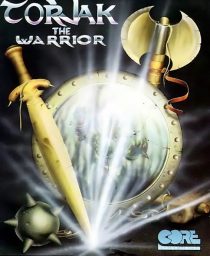 game from Core Design, which of course would go on to fame for creating the Tomb Raider series. Torvak is yet another poor barbarian warrior who comes home from the war to find the whole place burned down and all villagers slain by the forces of a necromancer. With no rest for the weary, Torvak picks up his axe and heads off to make the sumbitches pay.
game from Core Design, which of course would go on to fame for creating the Tomb Raider series. Torvak is yet another poor barbarian warrior who comes home from the war to find the whole place burned down and all villagers slain by the forces of a necromancer. With no rest for the weary, Torvak picks up his axe and heads off to make the sumbitches pay.
 Appendix N (Goodman Games): Much as I’d like to hope that Gary Gygax read Harold Lamb, he’s unlikely to have found his way to any of Lamb’s most influential work. It’s not that Lamb wasn’t in print. From the 1940s on, his histories and biographies were a mainstay on library shelves, and many modern libraries retain his books to this day. But as fine as they are – and some of them are very fine indeed – Lamb’s histories and biographies weren’t the texts that were important to Appendix N.
Appendix N (Goodman Games): Much as I’d like to hope that Gary Gygax read Harold Lamb, he’s unlikely to have found his way to any of Lamb’s most influential work. It’s not that Lamb wasn’t in print. From the 1940s on, his histories and biographies were a mainstay on library shelves, and many modern libraries retain his books to this day. But as fine as they are – and some of them are very fine indeed – Lamb’s histories and biographies weren’t the texts that were important to Appendix N.
Robert E. Howard (Sprague de Camp Fan): This story was written sometime in 1928. Robert E. Howard initially titled it “Delcardes’ Cat” but after introducing Thulsa Doom he retitled it “The Cat and the Skull.” Weird Tales rejected the story. Glenn Lord changed the title back to “Delcardes’ Cat” and it appeared for the first time in King Kull, Lancer Books, 1967. It is the fifth story in the collection.
sometime in 1928. Robert E. Howard initially titled it “Delcardes’ Cat” but after introducing Thulsa Doom he retitled it “The Cat and the Skull.” Weird Tales rejected the story. Glenn Lord changed the title back to “Delcardes’ Cat” and it appeared for the first time in King Kull, Lancer Books, 1967. It is the fifth story in the collection.
RPG (Walker’s Retreat): The tabletop RPG business–as opposed to the hobby–has been trying to squeeze blood from a stone for decades. The issue is that, as I explained yesterday and have said time and again before that, the medium of the tabletop RPG is at odds with the demands of commercial reality.
Gaming (Alexander Hellene): Look, I like video games. I grew up as a gamer. Being born in 1981, video games were unavoidable. Whether it was my maternal grandmother’s Atari (yes, she was a gamer) or the adventure games I played on my paternal grandfather’s old Leading Edge monochromatic P.C. (yes, he was a gamer too) or the NES my brother and I got for Christmas in, I think, 1987, I love video games as games.
RPG (Jon Mollison): They are at it again. The BROSR, lamenting the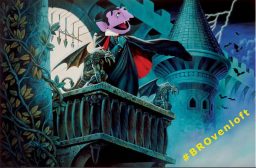 squandered opportunity that was Ravenloft spent all of five minutes talking about how much better the setting would have been had it only embraced the rules and ethos of AD&D before deciding to prove how great it could have been. A mad scramble ensued as players raced to claim one faction or another, and as I write this the dust has yet to settle. But we do have a few fun contenders you won’t find at any other table.
squandered opportunity that was Ravenloft spent all of five minutes talking about how much better the setting would have been had it only embraced the rules and ethos of AD&D before deciding to prove how great it could have been. A mad scramble ensued as players raced to claim one faction or another, and as I write this the dust has yet to settle. But we do have a few fun contenders you won’t find at any other table.
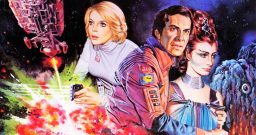 T.V. (Arkhaven Comics): Space 1999 completed its first season with a good deal of critical praise and a strong following among genre fans. A strong following doesn’t mean a big one. ITC head, Lew Grade had been very disappointed by the lack of an American network sale and as usual, was seeing very little reason to continue the show. It was pretty expensive and although it wasn’t losing money, it wasn’t making money either. Breaking even is not the desired endstate for any business.
T.V. (Arkhaven Comics): Space 1999 completed its first season with a good deal of critical praise and a strong following among genre fans. A strong following doesn’t mean a big one. ITC head, Lew Grade had been very disappointed by the lack of an American network sale and as usual, was seeing very little reason to continue the show. It was pretty expensive and although it wasn’t losing money, it wasn’t making money either. Breaking even is not the desired endstate for any business.
Fantasy (Grognardia): Originally published in the February 1942 issue of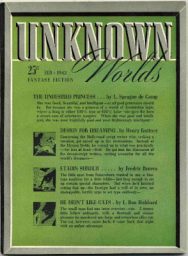 Unknown Worlds, “The Sunken Land” is an early adventure of Fafhrd and the Gray Mouser (the fourth in terms of publication). Consequently, it’s somewhat shorter than many of his later and more famous tales of the Twain.
Unknown Worlds, “The Sunken Land” is an early adventure of Fafhrd and the Gray Mouser (the fourth in terms of publication). Consequently, it’s somewhat shorter than many of his later and more famous tales of the Twain.
Dragonlance (Grognardia): Although there are 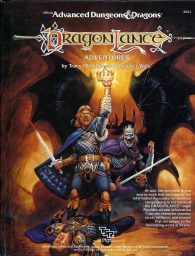 nearly four thousand posts on this blog, one of the most widely read remains “How Dragonlance Ruined Everything,” published all the way back in 2008. Though the title is intentionally hyperbolic, I largely stand behind what I wrote then, namely that the release and success of the Dragonlance series of adventure modules was the crowning achievement of the Hickman Revolution and forever changed the trajectory of Dungeons & Dragons.
nearly four thousand posts on this blog, one of the most widely read remains “How Dragonlance Ruined Everything,” published all the way back in 2008. Though the title is intentionally hyperbolic, I largely stand behind what I wrote then, namely that the release and success of the Dragonlance series of adventure modules was the crowning achievement of the Hickman Revolution and forever changed the trajectory of Dungeons & Dragons.
Art (DMR Books): “Kelly Freas, a prolific artist for over thirty years and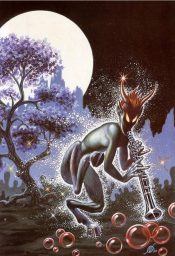 considered the “Dean of Science Fiction Artists,” has remained a fan favorite whose quality of work matched its quantity. Along the way, he created some of science fiction’s most iconic images and illustrated for noted authors such as Issac Asimov, Arthur C. Clarke and Clifford Simak among others.
considered the “Dean of Science Fiction Artists,” has remained a fan favorite whose quality of work matched its quantity. Along the way, he created some of science fiction’s most iconic images and illustrated for noted authors such as Issac Asimov, Arthur C. Clarke and Clifford Simak among others.
Art (DMR Books): Michael Wm. Kaluta turned 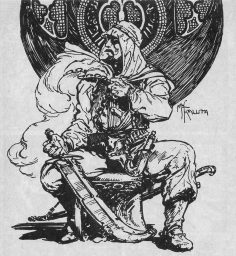 seventy-five the other day and I was asleep at the keyboard. Michael Wm. Kaluta (henceforth generally referred to as ‘Mike’ or ‘Kaluta’) was right there at the beginning, sword-brothers. Right there at the beginning for me, anyway.
seventy-five the other day and I was asleep at the keyboard. Michael Wm. Kaluta (henceforth generally referred to as ‘Mike’ or ‘Kaluta’) was right there at the beginning, sword-brothers. Right there at the beginning for me, anyway.
Western (Chimney Sweep Reader): Stephen Winston takes over the reins from Lou Cameron to pen this second book in the 31-book Easy Company series. 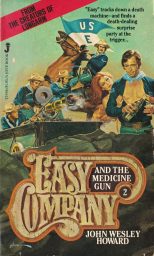 He would go on to write at least five more.
He would go on to write at least five more.
Less than a year after the events of Little Bighorn, Easy Company continues its mission of maintaining a shaky peace in the region. They are receiving new recruits due to some recent attrition and this novel’s plot centers around those characters although the regulars also get in on some good action. I get the feeling there might be a lot of new recruits necessary for this company of mounted infantry, (don’t dare call them cavalry) based on the body count in this outing alone.
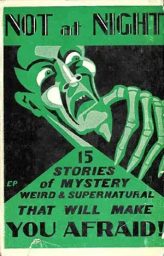 Horror (Dark Worlds Quarterly): In “Ghosts– Treat Them Gently!” (Evening News, 17 April 1931) , M. R James writes: On the whole, then, I say you must have horror and also malevolence. Not less necessary, however, is reticence. There is a series of books I have read, I think American in origin, called Not at Night (and with other like titles), which sin glaringly against this law. They have no other aim than that of Mrs. Wardle’s Fat Boy.
Horror (Dark Worlds Quarterly): In “Ghosts– Treat Them Gently!” (Evening News, 17 April 1931) , M. R James writes: On the whole, then, I say you must have horror and also malevolence. Not less necessary, however, is reticence. There is a series of books I have read, I think American in origin, called Not at Night (and with other like titles), which sin glaringly against this law. They have no other aim than that of Mrs. Wardle’s Fat Boy.
Fiction (Paperback Warrior): In 1955, Blood Alley was simultaneously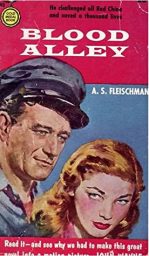 published as a novel and released as a film by Warner Brothers. The premise is that a U.S. Merchant Marine named Wilder is freed from a Chinese prison by a village hoping to utilize his services to escape to British-controlled Hong Kong. The book was authored by A.S. Fleischman, a popular Fawcett Gold Medal writer who specialized in exotic Asian locales to place his action-adventure novels.
published as a novel and released as a film by Warner Brothers. The premise is that a U.S. Merchant Marine named Wilder is freed from a Chinese prison by a village hoping to utilize his services to escape to British-controlled Hong Kong. The book was authored by A.S. Fleischman, a popular Fawcett Gold Medal writer who specialized in exotic Asian locales to place his action-adventure novels.
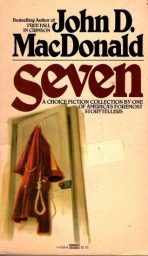 Fiction (Mostly Old Books): Interesting collection published in 1971 as the popularity for MacDonald’s Travis McGee series was taking off. The four shorter stories were published in Playboy and likely solicited. “Dear Old Friend” has an epistolary structure where through four shifting attempts at a dictated letter we learn the story. “The Annex” is sort of a white light story or a dream of a dying man. “Quarrel” is a bit of hilarity about an “accidental play” via tape recording. “Double Hannenframis,” my favorite of the shorter stories, is a neat noir about an executive caught insider trading and siphoning cash.
Fiction (Mostly Old Books): Interesting collection published in 1971 as the popularity for MacDonald’s Travis McGee series was taking off. The four shorter stories were published in Playboy and likely solicited. “Dear Old Friend” has an epistolary structure where through four shifting attempts at a dictated letter we learn the story. “The Annex” is sort of a white light story or a dream of a dying man. “Quarrel” is a bit of hilarity about an “accidental play” via tape recording. “Double Hannenframis,” my favorite of the shorter stories, is a neat noir about an executive caught insider trading and siphoning cash.
Horror (Bloody Spicy Books): “Slimer” by Harry Adam Knight or actually John Brosnan and Roy Kettle is one of those expensive ones. It also had a good reputation past having a bitchin’ cover, supposedly the book actually delivered. I was intrigued. Now, “Slimer” has been republished and is quite easy to pick up in trade-paperback or as an eBook. But that just wouldn’t do for a paperback weirdo for me.
Brosnan and Roy Kettle is one of those expensive ones. It also had a good reputation past having a bitchin’ cover, supposedly the book actually delivered. I was intrigued. Now, “Slimer” has been republished and is quite easy to pick up in trade-paperback or as an eBook. But that just wouldn’t do for a paperback weirdo for me.
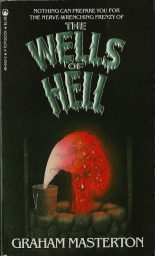 Horror (Too Much Horror Fiction): Graham Masterton, thanks be to him, is one of those standbys. For some time I’ve been hearing chatter, whether on Facebook or Instagram, Twitter or Reddit, about Masterton’s 1979* novel The Wells of Hell, which I believe was his 12th (yep, a dozen novels since his 1975 debut!). Don’t know how long I’ve owned a beat-up copy of the 1982 Tor/Pinnacle edition, which you see at the top there, lackluster cover art by artist unknown, and to be honest I never really gave it much thought till, as I said, hearing chatter about it.
Horror (Too Much Horror Fiction): Graham Masterton, thanks be to him, is one of those standbys. For some time I’ve been hearing chatter, whether on Facebook or Instagram, Twitter or Reddit, about Masterton’s 1979* novel The Wells of Hell, which I believe was his 12th (yep, a dozen novels since his 1975 debut!). Don’t know how long I’ve owned a beat-up copy of the 1982 Tor/Pinnacle edition, which you see at the top there, lackluster cover art by artist unknown, and to be honest I never really gave it much thought till, as I said, hearing chatter about it.
Art (Mens Pulp Mags): Artist Samson Pollen created hundreds of classic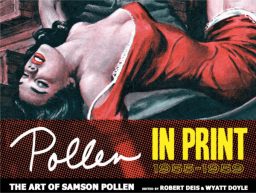 illustrations for the men’s adventure magazines (MAMs, for short) published in the 1950s, 1960s and 197os. He was one of the top illustrators who worked for the genre, along with artists like Mort Künstler, Gil Cohen, James Bama, Bruce Minney, Vic Prezio, Mel Crair, and Basil Gogos.
illustrations for the men’s adventure magazines (MAMs, for short) published in the 1950s, 1960s and 197os. He was one of the top illustrators who worked for the genre, along with artists like Mort Künstler, Gil Cohen, James Bama, Bruce Minney, Vic Prezio, Mel Crair, and Basil Gogos.
RPG (Morrus’ Unofficial Tabletop RPG News): In case you haven’t noticed we are in something of a boxed set Renaissance. Sure, they call them Starter Sets these days, but a lot of companies are reviving the tradition of peeling off the plastics and cracking open a few evenings worth of roleplaying. One of the first boxed sets that really caught my eye was the one for Call of Cthulhu 7th Edition.
Cinema (The Guardian): Who’s to blame for the ultimate failure of the most recent Star Wars trilogy? Ask some fans and they’ll point to JJ Abrams, who kicked it off to acclaim from most quarters with The Force Awakens, then completely ruined it with the baffling and ill-conceived Rise of Skywalker. Others will point to Rian Johnson, whose controversial second film The Last Jedi upset many fans for apparently trashing Luke Skywalker and making light of the Force, Jedi and Sith as little more than labels to be discarded when convenient.
recent Star Wars trilogy? Ask some fans and they’ll point to JJ Abrams, who kicked it off to acclaim from most quarters with The Force Awakens, then completely ruined it with the baffling and ill-conceived Rise of Skywalker. Others will point to Rian Johnson, whose controversial second film The Last Jedi upset many fans for apparently trashing Luke Skywalker and making light of the Force, Jedi and Sith as little more than labels to be discarded when convenient.
Please give us your valuable comment